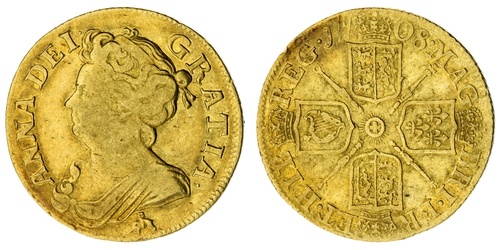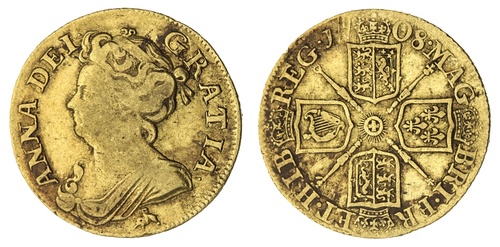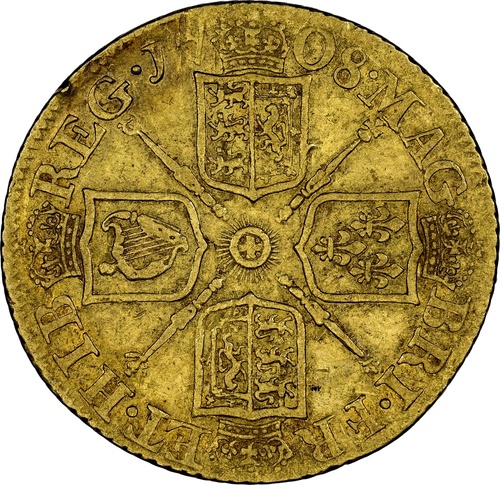Auction: 22027 - The "Ellerby Area" Hoard of English Gold Coins
Lot: 165
The Remarkable "Ellerby Area" Hoard of English Gold Coins (1610-1727) | NGC VF25 | *Top Pop* | Anne (1702-1714), Post-Union, 'Royal African Company', Elephant and Castle, Guinea, 1708, second draped bust left, E&C below, rev. crowned shields cruciform, six strings to harp, edge obliquely milled, 8.20g [126.5grns], 6h (PAS: YORYM-18E848 = BM 2019 T668/151 this coin; MCE 219 [VR]; Farey 515 [ER]; EGC -; Spink 3573), small edge marks, and a trace of adjustment above date, otherwise bright and residually lustrous, the portrait softly struck, nevertheless a bolder fine / very fine, excessively rare, with NGC 'Ellerby' Certification, graded VF25 (#6380983-151) [Single Finest Certified]
The 1708 'Elephant and Castle' Guinea is known with both the first (Pre-Union) and second (Post-Union) busts. The first bust type was not recorded until 1994, when the Schneider example was noted by Peter Woodhead when he began work on SCBI Volume Two of the Schneider Catalogue. Thus while it is not listed in the 1994 Standard Catalogue, it is to be found in the 1995 edition (Spink 3571), where it is not priced but is simply listed as 'extremely rare'. It has remained unpriced ever since. Naturally MCE, published in 1950, did not list the first bust type, and lists the second bust type as (219 VR). Unfortunately, though Peter Woodhead gave the Schneider example (Schneider 535) the correct Standard Catalogue reference (Spink 3571), he mistakenly gave the incorrect MCE reference.
Bull omits the second bust type altogether. It is possible he has mistakenly conflated it with the first bust type. He lists the extremely rare first bust type (EGC 469), illustrating the entry with the Schneider coin. The illustration is correctly captioned (Spink 3571; Schn. 535). Unfortunately in the entry for (EGC 469) he then gives the incorrect (MCE 219), perhaps following the Schneider listing, and also manages to give Spink 3671. This confusion may explain why the second bust type is then missed altogether. He also gives a rarity of R3, clearly not enough for a first bust type but perhaps correct for the second bust type, and so perhaps further evidence that he has conflated the two types.
Just to complete the picture of total confusion, Farey lists the second bust 1708 elephant and castle, but not the first bust.
After all this, the question now remains, how rare is the 1708 second bust Elephant and Castle Guinea? CoinArchives, a good guide to the last twenty years at auction, tells us that it has no record of a 1708 Elephant and Castle Guinea, neither first nor second bust. That is a good indication that we are dealing with a rarity. The next port of call must be the Montagu and Murdoch sales, and sure enough they both have one of this date, but first or second bust is not clear, nor is it certain whether or not they are one and the same coin. Both catalogue entries cite Ruding plate XVII no.3, and both say very rare, but the Murdoch catalogue does not say the coin is from the Montagu collection.
Subject to 20% VAT on Buyer’s Premium. For more information please view Terms and Conditions for Buyers.
Sold for
£20,000
Starting price
£900











